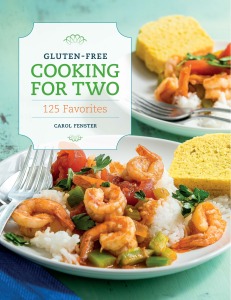I was preparing dinner one night when I had a BFO (Blinding Flash of the Obvious):
I realized that I live in a two-person household, yet I’ve always cooked for the standard family-of-four. That worked well when my son was growing up because he ate all of the leftovers, but now my husband and I are empty-nesters. Full-size recipes yield too much food, my husband dislikes leftovers (meatloaf! again?), and I hate wasting food.
Raised by depression-era parents (clean your plate!), my upbringing instilled a sense of guilt about wasting food. So, after scaling down all of my recipes I now prepare just enough food for two people and we have far less waste at our house.
I transformed all of this information into my latest cookbook, Gluten-Free Cooking for Two. The book has a wide variety of dishes: entrees, breads, breakfasts, soups, and desserts to entice you. Learn more about the recipes at my website.
I believe that everyone deserves food that is nourishing and suits their needs, regardless of special diets or household size. If this is you, then my new cookbook is right for you.
This is what I learned from converting 125 of my favorite full-size recipes to serve two people:
[1] Start with a Recipe for Two Servings
It is so tempting to just wing it and halve a 4-serving recipe to serve two. Trust me— it doesn’t always lead to success because not all ingredients scale down proportionately. I recently halved a simple 4-serving recipe for Butternut Squash Soup, just to prove my point. (After all, how hard could this be?) Well, the soup was under-seasoned and the ratio of liquids (broth) to solids (butternut squash) was “off” making the soup too thick. After I added more seasoning and more broth, the ingredients were balanced and the soup was perfect. Clearly, even the simplest recipes might need tweaking when downsizing them to two servings.
Balancing ingredients is even more important when scaling down recipes for baking. (How do you measure 1/3 of an egg?) My mother’s fail-proof chocolate cake—which I baked for decades—is the perfect example. I thought scaling down this recipe to fit a 5-inch cake pan would be a “piece of cake.” (Sorry, I just had to say it.) Instead, a dozen tries later, I finally balanced the ingredients to produce a miniature replica of the cake that has brought my family so much joy.
The moral of this story? Unless you like kitchen math and hours of experimentation, use a two-serving recipe to start with for best results.
[2] Think Small for Big Benefits
Small-scale cooking requires a different mind-set. You cook only what you need, using ingredients and utensils that seem impossibly small (e.g., 1/3 cup flour instead of 2 cups or a 3×5-inch loaf pan instead of 5×9). It’s almost a “dollhouse” mentality because the utensils and food are so darn cute. But the payoff is big! No leftovers and no food waste. Right-size recipes also prevent over-indulgence and offer automatic portion control if you’re trying to cut calories.
[3] Measure Accurately; No Eyeballing
Eye-balling is risky in small-scale cooking. This is because the overall volume of the ingredients is incredibly small, e.g., some batters barely measure 1 cup. So, even a tablespoon too much (or too little) of flour or liquid can upset the balance of wet-to-dry ingredients. In other words, the margin for error is quite small so correct measuring is critical.
Measuring small amounts of salt, seasonings, and leavenings requires precision. Rather than standard measuring spoons which are too big, use mini-measuring spoons for 1/8, 1/16, 1/32, and 1/64 teaspoon (the spoons are labeled as dash, pinch, smidgeon, or drop, respectively). You can find them in the baking aisle of grocery stores, in kitchen stores, or online.
[4] Use Small-Scale Baking Pans
Make sure you have the right pans. You can keep your 9×13-inch baking sheet for cookies or 5×9-inch pan for Brownies. But you may need to invest in additional, small-scale pans. For example, many recipes call for a straight-sided 2-quart saucepan (4-inch sides, 6-inch diameter) because it is just the right size to surround the entrée in enough liquid so it doesn’t boil dry. A shallower pan lets the juices evaporate too quickly and can lead to a dry dish.
In baking, use the suggested pan because the volume of dough/batter and the baking times have been carefully calibrated for that particular pan. Baking times are usually shorter than usual because smaller pans allow the heat to penetrate to the center of the dish more quickly than with larger pans.
[5] The Benefit of Cooking Small
Once you get the hang of it, cooking small becomes a way of life. Your payoff is fewer leftovers, less wasted food, and happier husbands.
******Carol Fenster now cooks all of her meals in two-serving portions and is the author of 14 cookbooks, including, Gluten-Free Cooking Two (Houghton Mifflin Harcourt, 2017). She blogs at www.CarolFensterCooks.com. Her website is www.CarolFenster.com.























